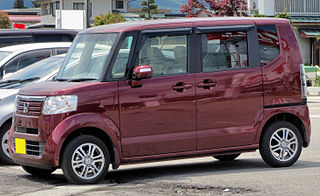
Kei car is the smallest category of Japanese expressway-legal motor vehicles. The term 'Kei' is a shortening of kei-jidōsha,, which translates to English as "light automobile".
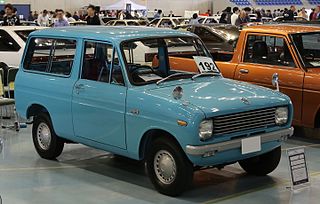
The Mazda Porter and Porter Cab are a series of small kei trucks that were produced from 1961 to 1989 by Mazda, mainly for sale in the domestic Japanese market. Export versions of the Porter were labelled E360. The Porter was replaced by the Autozam Scrum, a rebadged Suzuki Carry.

The Daihatsu Fellow Max is a small Japanese automobile in the Kei car class. Originally introduced as the Daihatsu Fellow, the name was partially retained for its successor, the Max Cuore (1977), and then revived in 2000 for the Daihatsu Max.

The Mitsubishi Minica is a model series of kei cars, produced by Mitsubishi Motors Corp. (MMC) over five generations, from 1962 to 2011, mainly for the Japanese domestic market.
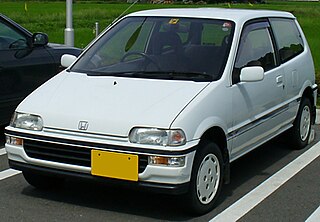
The Honda Today is a kei car produced by Japanese automaker Honda beginning in 1985. It was replaced by the Honda Life in 1998.
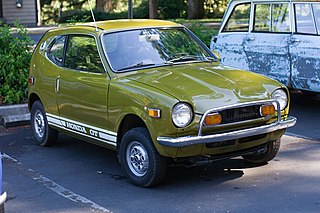
The Honda Z is a two-door hatchback kei car/city car manufactured and marketed by the Honda Motor Company, from 1970 until 1974. Exports mostly ended after 1972, when the domestic market models received redesigned pillarless bodywork.
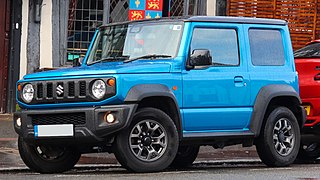
The Suzuki Jimny is a series of four-wheel drive off-road mini SUVs, manufactured and marketed by Japanese automaker Suzuki since 1970.

The Daihatsu Hijet is a cab over microvan and kei truck produced and sold by the Japanese automaker Daihatsu since 1960. Despite the similarities between the Hijet name and Toyota's naming scheme for its trucks and vans, the name "Hijet" has been in use for Daihatsu's kei trucks and microvans since 1960, over two decades before Toyota took control. "Hijet", when transliterated into Japanese, is very similar to "Midget", one of Daihatsu's other mini-trucks. According to Daihatsu, the name "Hijet" was created to imply that the vehicle offers higher performance than the Midget. The Hijet competes in Japan with the Honda Acty, Mitsubishi Minicab, Nissan Clipper, Subaru Sambar and Suzuki Carry.

The Honda Acty is a series of cabover microvans and kei trucks produced by the Japanese automaker Honda from 1977 to 2021, designed for the Japanese domestic market (JDM). "Acty" is short for "Activity".

The Honda Life is an automobile nameplate that was used on various kei car/city cars produced by Honda: passenger cars, microvans, and kei trucks. The first series of the nameplate was built between 1971 and 1974, with the nameplate revived in 1997 and used until 2014. The Japanese-market Life has rarely been marketed outside Japan.

The Honda N360 is a small front-engine, front-wheel drive, two-door, four-passenger car manufactured and marketed by Honda from March 1967 through 1970 in Japan's highly regulated kei class — as both a two-door sedan and three-door wagon.
The Honda Vamos is a leisure vehicle originally produced by Japanese automaker Honda from 1970 to 1973, and reintroduced again as a trim level of the Honda Acty microvan starting in 1999. Its name, "Vamos", is Spanish and Portuguese for "let's go".

The Subaru Sambar is a cabover truck and microvan manufactured and marketed by Subaru as Japan's second truck compliant with the country's strict Keitora (軽トラ) or Kei vehicle tax class, after the Kurogane Baby. Introduced in 1961 in microvan and Kei pickup configurations, the Sambar remains in production, now in its eighth generation — beginning with the sixth generation as a rebadged Daihatsu Hijet.
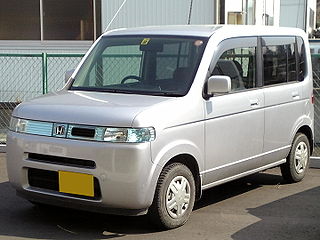
The Honda That's is a kei car manufactured by Honda between 2002 and 2007 for the Japanese market. The That's is based on the third-generation Honda Life kei car platform with a five-door "tall wagon" hatchback body, with considerable height.

The Suzuki Carry is a kei truck produced by the Japanese automaker Suzuki. The microvan version was originally called the Carry van until 1982 when the passenger van versions were renamed as the Suzuki Every. In Japan, the Carry and Every are kei cars but the Suzuki Every Plus, the bigger version of Every, had a longer bonnet for safety purposes and a larger engine; export market versions and derivatives have been fitted with engines of up to 1.6 liters displacement. They have been sold under myriad different names in several countries, and is the only car to have been offered with Chevrolet as well as Ford badges.

The Mitsubishi Mizushima is the first of a series of three-wheeled cargo carriers made in Japan by Mitsubishi between 1947 and 1962. A number of prototypes were built in 1946, leading to series production beginning in May 1947. Along with the Silver Pigeon scooter it represented the company's first contributions to the Japanese post-war personal transport boom.

A kei truck, kei-class truck, or Japanese mini truck, known in Japan as a keitora, is a style of pickup truck built to satisfy the Japanese keijidōsha statutory class of light vehicles. Limited to certain size restrictions—currently no more than 3.4 m (11.2 ft) long and 1.48 m (4.9 ft) wide—they are produced by a wide range of Japanese automakers and are available in rear-wheel or four-wheel drive.

Suzulight was the brand used for kei cars built by the Suzuki Motor Corporation from 1955 to 1969. They were Suzuki's first entry into automotive manufacturing, having previously only produced motorcycles. The Suzulight sedans and light vans all had transversely mounted engines and front-wheel drive. The Suzulight Carry trucks and vans were the first to use the Carry label, still around today.
The Hino Briska was a small pickup truck built by Hino Motors, adapted from the Renault-based Hino Contessa sedan. It was introduced in 1961 and remained in production until 1968, when Toyota released the Toyota Hilux. In 1967, the Hino Briska was renamed the Toyota Briska, then the Hilux was introduced, based on the Briska. There was also a commercial delivery van, appropriately called the Hino Commerce.
The Daihatsu New-Line was a compact series of pickup trucks and vans built by Daihatsu from 1963 until 1968. They were based on the Daihatsu Hijet "keitora" and microvans, although they were somewhat larger and sturdier. The 797 cc inline-four engine also seen in the Daihatsu Compagno was fitted, rather than the 356 cc two-stroke unit seen in the Hijet.






















